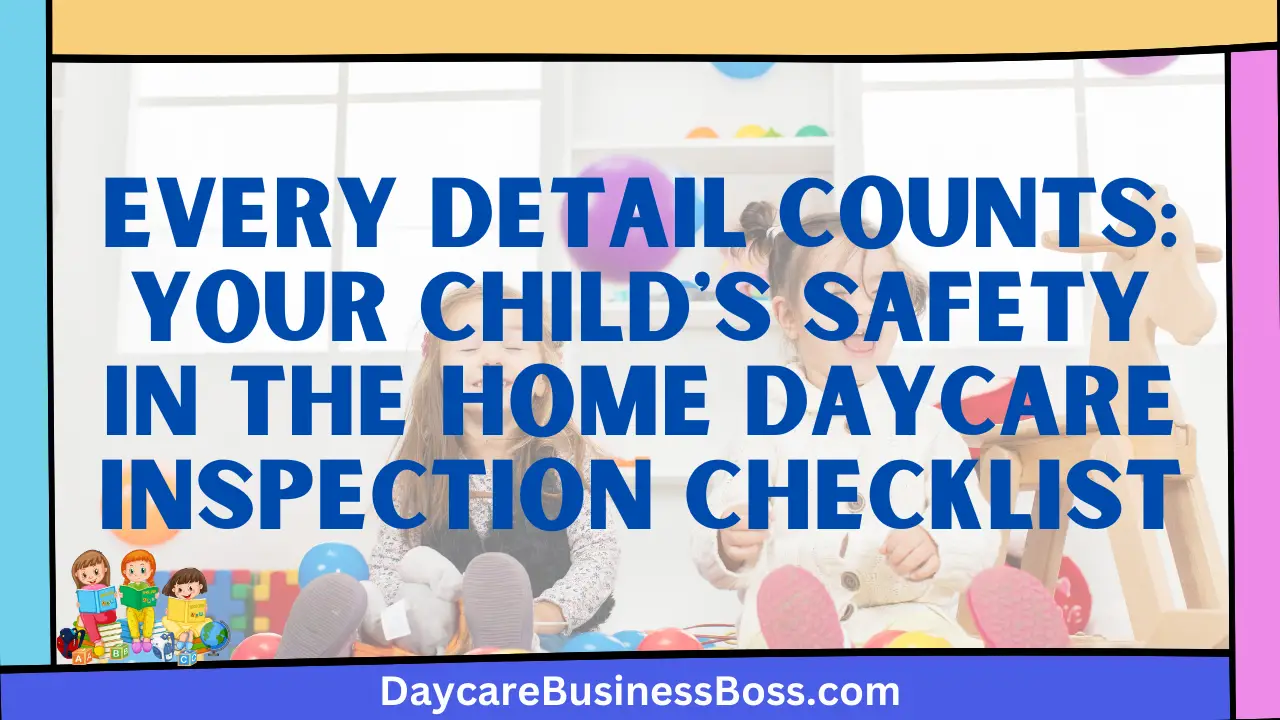It is critical to ensure the safety, well-being, and optimal development of children in childcare settings. A carefully developed daycare inspection checklist is an essential tool for ensuring that every part of a daycare facility adheres to the highest standards of care and safety.
The most useful daycare inspection checklist includes safety measures, childproofing, sanitation, staff-to-child ratios, readiness for first aid, fire exits, background checks, proper licensing, cleanliness, age-appropriate toys, and emergency plans.
This article digs into the essential components of a complete daycare inspection checklist, highlighting the significance of each criterion and its role in creating a safe and caring environment for children.
Safety Measures: Shielding the Vulnerable
Safety precautions include a wide range of proactive steps carefully crafted to protect children from potential hazards. This holistic method includes a thorough study of the physical structure of the facility, identifying potential danger zones, and quickly correcting them. It includes securing heavy furniture, limiting access to sharp objects that may be within children’s reach, and creating a safe atmosphere for them to explore and play.
Non-negotiable components include strategically placed fire extinguishers, smoke detectors, and carbon monoxide detectors. Their placement is not a one-time event; rather, it is part of a long-term commitment to safety. Regular checks and maintenance routines are required to ensure that these devices remain fully functional and ready to respond quickly in the event of an emergency. These precise safety precautions work together to provide a nurturing environment where children’s well-being and protection come first.
Childproofing: Minimizing Risks
Childproofing is critical in preventing accidents and protecting children from potential injury. Several measures are required to achieve an atmosphere of maximum security. This includes diligently covering all electrical outlets and keeping them safe from prying eyes. Cleaning supply cabinets are properly stored away, avoiding the potential of inadvertent exposure. Removing choking hazards with care is critical to guarantee the child’s safety.
Staircases are methodically gated to prevent unintentional falls because they are a potential hazard. Similarly, windows are reinforced to prevent accidents, adding an extra degree of security. The essence of childproofing extends even to play area design. Padding acts as a protective buffer, effectively cushioning any unintentional falls during play. These procedures are the heart of childproofing, a deliberate attempt that ensures a safe sanctuary for children to explore and flourish, free of the unnecessary hazards of accidents and injuries.
Sanitation: Health and Hygiene
The importance of maintaining a clean and sanitary environment for children’s health cannot be overstated. A constant disinfection schedule for surfaces, toys, and play equipment acts as a significant barrier against the spread of hazardous pathogens. Adherence to correct diaper-changing routines and thorough handwashing techniques is critical since it dramatically reduces the risk of infection transmission.
Responsible waste disposal eliminates possible sources of contamination, while good ventilation contributes to the establishment of a healthy environment. Adequate ventilation not only removes pollutants but also keeps air quality at an acceptable level. These activities, when combined, provide a health-focused environment that promotes children’s well-being and growth. Daycare facilities establish an atmosphere where children can thrive without being exposed to needless health hazards by adhering to strict cleaning and hygiene requirements.
Staff-to-Child Ratios: Individualized Attention

Maintaining ideal staff-to-child ratios is critical to providing each child with thorough attention and care. The significance of this ratio grows with the age of the children, as their needs and demands change. Because of their sensitivity and need, newborns require a higher amount of customized attention.
The purpose of this technique is to enable not only everyday caregiving but also a rapid response in times of need. Adequate staffing enables caregivers to respond quickly to children’s needs, whether they are delivering comfort, reacting to medical problems, or catering to daily routines. In an emergency, this balance ensures that each child’s safety and well-being are prioritized. Daycare facilities provide an environment where children’s needs are met efficiently, allowing for optimal growth, learning, and emotional development by accepting proper staff-to-child ratios.
Read more about: Dollars, Sense, and Childcare: The Importance of Daycare Profit Margin
Readiness for First Aid: Swift Response
Ensuring childcare worker competency in basic first aid and CPR is an essential component of protecting children’s well-being. Equipping employees with these abilities allows them to respond quickly and efficiently to unexpected medical crises. Along with training, having a well-stocked first aid bag within arm’s reach is critical. This direct access allows for rapid intervention in crucial situations, perhaps averting consequences.
The growth of these strategies, however, is dependent on ongoing learning and practice. Regular training sessions are vital tools for updating staff knowledge, honing their skills and keeping them up to date on the most recent medical practices. This continuing training covers a variety of circumstances, ranging from minor injuries to severe allergic responses or medical problems. Daycare personnel becomes a key safety net by building confidence via preparedness, ensuring that children receive essential care promptly and competently.
Fire Exits: Clear Pathways to Safety
Emergency scenarios must have marked fire exits that are not obstructed. During critical circumstances, these exit routes act as lifelines, ensuring the safe evacuation of children and workers. Fire drills are important components of preparation because they familiarize both staff and students with the complexities of evacuation procedures. These drills help to provide a calm and organized reaction during actual emergencies, reducing panic and confusion.
Access to fire extinguishers, in addition to exits, is critical. These firefighting tools should be strategically placed throughout the site and easily accessible in times of emergency. Ensuring that staff employees are well-versed in their use through thorough training strengthens the safety net even further. This training enables them to act quickly and efficiently, enhancing the safety of all individuals within the daycare center. These measures, taken together, constitute a strong framework that emphasizes the importance of proactive fire protection measures.
Background Checks: Trustworthiness and Security
Conducting thorough background checks on both staff and volunteers is critical to ensuring a secure atmosphere in daycare centers. This stringent screening process acts as a key barrier against possible risks, reducing the possibility of people with criminal records or inappropriate behavior obtaining contact with children.
A thorough background check assists in recognizing red flags, ensuring that people entrusted with the care of children are of the highest integrity and reliability. Daycare directors can protect the well-being of every kid in their care by reviewing criminal records, past habits, and career histories.
This tight practice exemplifies a proactive approach to child protection, instilling trust and safety in parents and caregivers alike. Doing thorough background checks is an important step toward providing a loving atmosphere in which children can develop without being exposed to unwarranted risks.
Proper Licensing: Meeting Legal Requirements
Maintaining proper licensing and adhering to regulatory rules is an essential component of running a reputable daycare. Licensing represents a commitment to upholding stringent standards in the areas of safety, hygiene, and operational regulations. It is a visual demonstration of a daycare’s commitment to providing a safe and caring environment for children.
Regular inspections by competent authorities are key to this commitment. These evaluations guarantee that the childcare achieves or exceeds the stated benchmarks consistently. Inspections serve as a check and balance mechanism, reinforcing the facility’s and its employees’ accountability. Any deviations from the established norms can be quickly discovered and corrected through these evaluations, sustaining a continuous cycle of progress.
The symbiotic link between licensing, adherence to requirements, and stringent inspections enhances the quality of care offered by daycare providers. This collaborative effort demonstrates the organization’s unwavering dedication to the well-being and growth of the children entrusted to their care.
Cleanliness: A Hygienic Haven

In a daycare setting, cleanliness extends beyond basic sanitation to include a holistic approach to hygiene. This includes cleaning only routinely removing dirt and germs, but also creating structured, clutter-free rooms that encourage an optimal learning and playing environment for children.
This dedication extends to methodically cleaning play areas and ensuring toys are sorted and easily accessible. Regular laundering of bedding and soft toys is essential because it reduces the accumulation of allergies and bacteria, encouraging a healthier environment for children. A clean atmosphere not only provides an aesthetically pleasing setting but also minimizes the prevalence of allergies and infections, contributing to both children’s and staff’s general well-being.
The holistic approach to hygiene not only eliminates health issues but also instills excellent behaviors and values in youngsters. It emphasizes the significance of keeping an organized environment and lays the groundwork for lifelong habits of cleanliness and tidiness.
Read more about: Daycare Evaluation 101: What to Include in Your Checklist
Age-Appropriate Toys: Promoting Development
Toys have an important role in molding children’s development, serving as catalysts for learning and growth. The importance of this function is emphasized through the supply of age-appropriate toys that correspond to children’s developmental phases. These toys serve multiple functions, including encouraging creativity, honing motor abilities, and supporting cognitive development.
However, the utility of these toys is increased when they are supplemented with tight safety procedures. Toys must be inspected regularly to ensure they are free of faults, damage, and potential risks. Eliminating choking hazards by rigorously inspecting the size and components of toys is an essential part of this process.
Daycare facilities improve children’s overall development by sticking to the practice of providing safe and stimulating toys. This dedication not only fuels their learning journey but also ensures a safe and enriching play environment, which contributes considerably to their overall development.
Emergency Plans: Preparedness Matters
The presence of well-defined emergency plans within daycare facilities is a vital safety pillar. These painstakingly prepared plans defend against a wide range of potential crises, including medical emergencies, natural disasters, and the necessity for lockdown measures. Their comprehensive character provides readiness for a wide range of eventualities, establishing trust in both professionals and children.
Practice increases the effectiveness of these emergency preparations. Drills are important instruments for familiarizing both staff and children with the necessary actions in the case of adversity. These simulations instill a sense of preparedness, ensuring that reactions are quick, intentional, and by established norms. The combination of rigorous planning and regular practice creates a strong barrier against uncertainty, cultivating an environment where safety and well-being prevail even in the most difficult circumstances.
Frequently Asked Questions

What is the significance of a childcare inspection checklist?
A daycare inspection checklist is essential for maintaining children’s safety, health, and overall well-being at daycare facilities. It specifies critical criteria such as safety precautions, childproofing, worker ratios, sanitation, and emergency preparations. Daycare providers who follow this criterion can maintain high levels of care while giving parents peace of mind.
What does the staff-to-child ratio imply, and why is it important?
The number of caregivers or staff members assigned to oversee a given number of children in a daycare setting is referred to as the staff-to-child ratio. This ratio fluctuates according to the age of the children. It is critical to maintain optimal ratios to ensure that each child receives adequate attention, supervision, and care. Proper ratios contribute to a safer environment and allow caregivers to respond quickly to the needs of youngsters.
How frequently should a daycare facility do emergency drills?
Daycare facilities should conduct emergency drills regularly to ensure that they are prepared for a variety of emergencies. Fire evacuations, lockdowns, and medical emergency responses are all common drills. Drills should be conducted at least quarterly, depending on local legislation and facility standards. Regular exercises allow both staff and children to become acquainted with emergency protocols, supporting a quick and orderly response in real-life emergencies.
To learn more on how to start your own daycare checkout my startup documents here.
The information provided by DaycareBusinessBoss.com (“The Site”) is for general informational purposes only. All information on the Site is provided in good faith, however, we make no representation or warranty of any kind, express or implied, regarding the accuracy, adequacy, validity, reliability, availability or completeness of any information on the Site. Under no circumstance shall we have any liability to you for any loss or damage of any kind incurred as a result of the use of the Site or Reliance on any information provided on the Site. Your use of the Site and your reliance on any information on the Site is solely at your own risk.
This blog post is for educational purposes only and does not constitute legal advice. Please consult a legal expert to address your specific needs. Terms and Conditions. (https://daycarebusinessboss.com/terms-conditions/)

Meet Shawn Chun: Entrepreneur and Childcare Business Fan.
I’m a happy individual who happens to be an entrepreneur. I have owned several types of businesses in my life from a coffee shop to an import and export business to an online review business plus a few more and now I create online daycare business resources for those interested in starting new ventures. It’s demanding work but I love it. I do it for those passionate about their business and their goals. That’s why when I meet a childcare business owner, I see myself. I know how hard the struggle is to retain clients, find good employees and keep the business growing all while trying to stay competitive.
That’s why I created Daycare Business Boss: I want to help childcare business owners like you build a thriving business that brings you endless joy and supports your ideal lifestyle.


